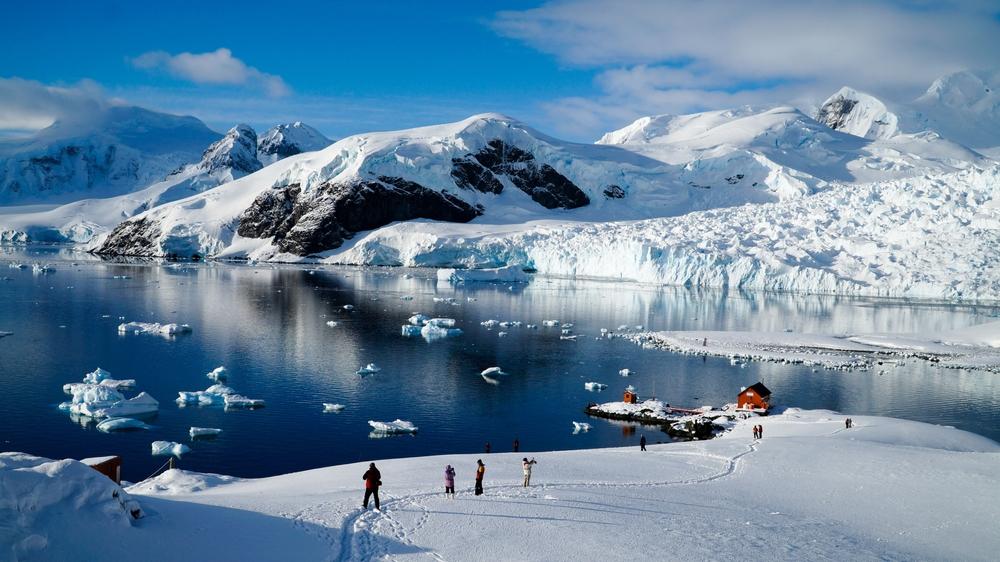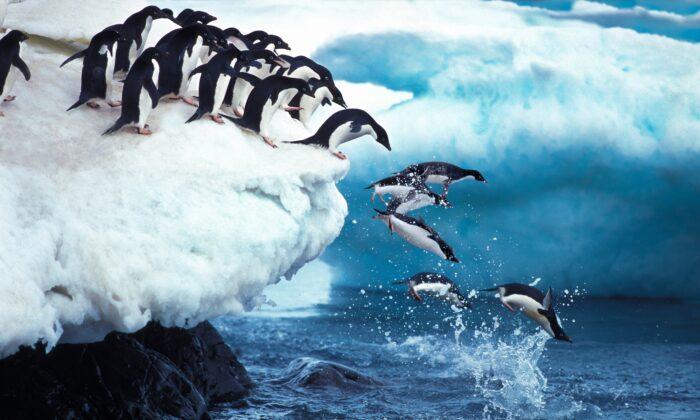I have never been to the moon, or any other planet beyond, of course, Earth. But I do know what it’s like to land on terra incognito, and enter a landscape that is—literally, mostly—unknown. To be surrounded by the alien.
When you steam south from Ushuaia, as most Antarctica-bound ships do, you have no idea and can’t even fathom, what lies ahead. The world’s southernmost city, Ushuaia is Patagonia-pretty. Colorful shops selling outdoor gear line an undulating Main Street. Restaurants along the waterfront do brisk business in crab leg dinners. Seen from the water, the whole place climbs a rise, backdropped by snow-capped mountains. There’s a famous Argentinian national park just nearby, for picnics and daylong hikes.
But leaving the busy pier on board a southbound ship is akin to departing our regular, known orbit. First, of course, you must cross the infamous Drake Passage, perhaps the most tumultuous stretch of sea on earth. Here, mighty currents of Southern Ocean, carried by the powerful Antarctic Circumpolar Current, are squeezed through a narrow 500-mile span, unblocked by any land mass.
I always relate this to turning a garden hose on full blast, then holding your thumb over the end—white water is inevitable. Veterans speak about two possibilities for the passage—“Drake Lake” or “Drake Shake.” The former is when the passage is unusually calm. But on my various crossings, I’ve almost always experienced the latter. Swell rising to 30-foot waves. Winds rising to hurricane-force gusts.
And then, when you first see it, you can scarcely believe your eyes. The coldest, driest, windiest, highest, darkest, most remote continent on earth. A desert where ice and snow can date back 10,000 years. Mountain peaks that have never been climbed. Whole huge swathes of land where man has never set foot—or, at least, not anytime lately.
Despite the inevitable tumult and roil on the Drake, these days, voyages to the ultimate south are safe and comfortable. Every year, more and more luxury expedition ships are built and christened and launched. No matter what the weather outside, guests return to their vessel and are welcomed with warm drinks, with maybe a cocktail, with steak and lobster tail waiting on the menu later that evening.
But still, this is a destination that makes you feel like an explorer. Like you’re sailing right off the map. I’ve visited five times, and this vast, frozen continent keeps drawing me back, like metal to the magnetic South Pole.

It’s a feeling I share with those actual, real explorers, from what’s now known as the Heroic Age of Exploration. What’s truly remarkable: how very little was known about Antarctica until very recently. An entire continent. A total of 5.5 million square miles. A lot bigger than Europe. But while its reality had been theorized, and Captain James Cook came very close to it in 1773, no human actually laid eyes on this continent until 1820. (There’s some debate about whether the Russians or the British saw it first, but they both saw it in the same year.)
Exploration really began in earnest around the turn of the 20th century—the dawn of the Heroic Age. Nations, and men, competed to plant their flags. In a three-year expedition from 1901 to 1904, two towering personalities—Captain Robert Falcon Scott and Ernest Shackleton—came within about 400 miles of the South Pole before turning back. Arriving back at their ship, fellow sailors described them, so heavily weathered from the harsh element, as “almost unrecognizable.”
In 1909, Shackleton, with his right-hand man Frank Wild, came even closer to the Pole, less than 100 miles, but it almost cost them their lives. In 1911, Norwegian explorer Roald Amundsen finally reached the Pole, just weeks before Robert Falcon Scott and his party also get there, in second place. Scott, and all his men, perished on their return trip to their ship.
But the most famous episode of exploration here, of course, was Shackleton’s epic Trans-Antarctic Expedition. Aiming to be the first person to cross the continent via the South Pole, his expedition, aboard the ship, Endurance, set sail in 1914. They entered an ice-choked Weddell Sea and became lodged in it. Whole books have been written on the months and years that ensued.
The ship was crushed and lost in 1915, and the 28 men then lived in an “Ocean Camp” on shifting ice floes. Making it to Elephant Island, more than 100 miles away, they survived on a diet of penguins and seals and slept under their lifeboats. In an desperate and daring attempt to survive, Shackleton took a crew of six and sailed the James Caird, a 23-foot lifeboat, 800 miles through a tempest to the closest known human settlement, at the whaling stations on South Georgia Island.
Against all odds, they made it—a miracle by any standard. Finding this small speck of land in the vast Southern Ocean, a storm forced them to land on the far side of the island. Shackleton, his captain Frank Worsley, and Second Officer Tom Crean then trekked 36 straight hours over soaring mountains and deep, crevassed glaciers to find help.
When Shackleton and his men entered the whaling Norwegian whaling station at Stromness, the hardened whaler who saw them first broke down and wept. They’d been assumed lost for a year and a half. Shackleton rescued the crew left on Elephant Island, four months after he had left them there under the command of Wild.

Today, the Heroic Age long over, Antarctica still enchants. Researchers spend summers (and a relative handful, dark winters) at 82 stations, built by 30 different nations. And a growing number of travelers, almost always arriving by ship, join them.
The remoteness, the feeling of otherworldliness, it’s all part of the appeal. Landing on snow-covered islands and walking among penguins—gentoos, chinstraps, kings, Adelies. Zooming around icebergs in zodiacs, spotting seals taking a nap on top. Seeing glaciers calve, and massive wandering albatrosses, swoop, and whales turn tail and show you their flukes.
All part of the reason why I’ll keep going back, as often as I can. A chance to feel like Shackleton. As long as there’s a T-bone steak and some lobster and a warm bed awaiting me, back on the ship.






